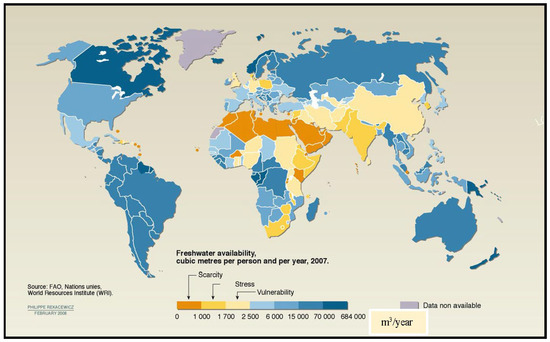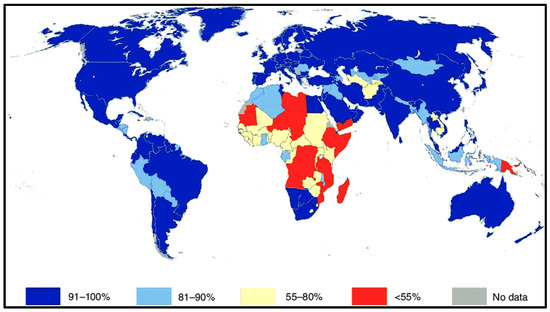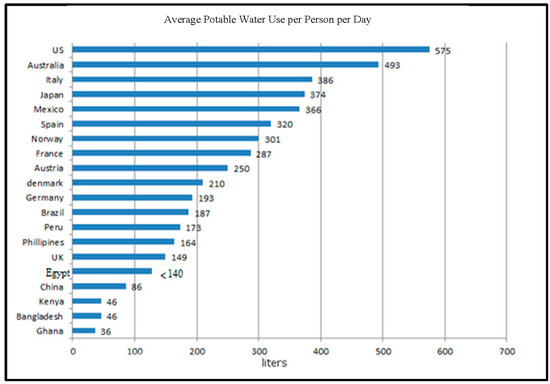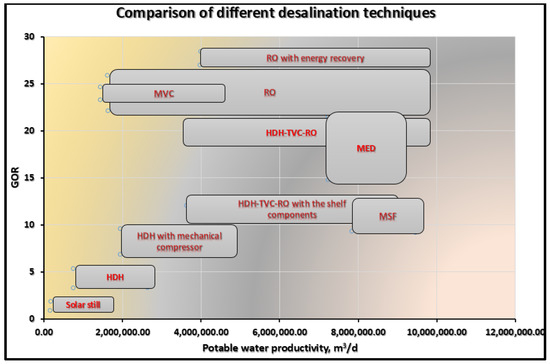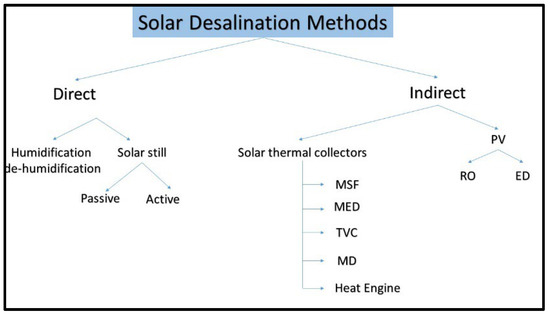Access to clean, potable water is crucial for all living beings and is used for various purposes such as drinking, household activities, agriculture, and industrial processes. The impact of water scarcity affects many parts of the world, with approximately 3.7 billion people currently experiencing water scarcity. Solar desalination systems are a promising solution to the water scarcity problem since the majority of the earth’s water resources are salty. With the increasing focus on desalination research, many innovative methods are being developed to extract salts from saline water. Energy consumption is a significant concern in desalination, and renewable energy, particularly solar energy, is considered a viable alternative to fossil fuel energy.
1. Introduction
Access to clean, potable water is crucial for all living beings and is used for various purposes such as drinking, household activities, agriculture, and industrial processes. The annual minimum requirement for an individual’s potable water needs is estimated to be approximately 1000 m
3 [
1]. When the annual potable water supply for an individual falls below 1000 m
3, it is considered a severe crisis, while water stress starts between 1000 m
3 and 1700 m
3 per person [
2]. The impact of water scarcity affects many parts of the world, with approximately 3.7 billion people currently experiencing water scarcity [
3]. Unfortunately, this number is expected to rise by almost 2 billion people by 2050 [
3]. Consistent and excessive use of potable water resources can lead to an environmental disaster. The Population Action International Institute has estimated that by 2050, potable water sufficiency, stress, and scarcity will be 58%, 24%, and 18%, respectively [
4].
Figure 1 and
Figure 2 illustrate the global potable water scarcity and stress, respectively, in 2007 and 1995/2025 [
4,
5]. The demand for potable water has doubled from almost 4.2 million m
3 in the past 50 years to 30% of the accessible potable water supply by 2000, with estimates that it will reach 70% by 2025 [
2]. This consumption pattern creates a significant disparity between developed and developing countries, with Egypt’s daily potable water consumption being less than 0.2 m
3 per person in contrast to Canada’s 0.274 m
3 per person in 2004 [
6].
Figure 3 depicts the daily use of potable water per person in 2010 and highlights the vast gap between developed and developing countries [
7].
Figure 1. Global potable water scarcity map in 2007 [
4].
Figure 2. Worldwide potable water stress in 1995 and 2025 [
3].
Figure 3. Daily use of potable water per person in different countries in 2010 [
7].
According to The United Nations Children’s Fund (UNICEF), approximately 884 million people utilize contaminated potable water. Nearly 60% of people were provided with improved potable water via artificial means for drinking by public standpipes, boreholes, protected springs, household connections, rainwater and a protected dug well [
4].
Figure 4 indicates the global consumption of improved potable water in 2008 [
8]. The aforementioned causes push researchers to provide a viable solution for water scarcity. One of these solutions is desalination. Nowadays, the overwhelming majority of nations depend mainly on desalination.
Figure 5 indicates the amount of freshwater that could be produced using desalination. From this graph, we can observe that some desalination techniques could offer up to 10
6 m
3/d.
Figure 4. Worldwide use of potable water in 2008 [
8].
Figure 5. The performance of different desalination techniques.
2. Method of Desalination
The main concept of desalination is removing salts from water and it involves two main methods:
-
Thermal desalination: works by vaporizing the saline water to separate the salt and then condensing the vapor. Therefore, heat is considered the main driving force to separate water from salts, such as multi-effect desalination (MED), the humidification–dehumidification method (HDH) and multi-stage flash desalination (MSF) [
9]. The main merit of thermal methods is using low-grade energy, flexibility and a simple design. This process can be powered by solar energy.
-
Membrane distillation: water vapor is forced to pass through a membrane, leaving salt on one side. The main advantage of the membrane method is mass production. However, the main issue of desalination is reducing the energy required and increasing the dependency on renewable energy as well.
-
Other methods such as chemical approaches, such as ion exchange, gas hydrate, and liquid-to-liquid extraction, differ greatly from thermal and semi-permeable membrane desalination. Ion exchange, for example, requires expensive chemicals and is only practical for treating low-saline water.
Desalination also provides low-cost potable water between 0.5 USD/m
3 and 1 USD/m
3 [
10]. The global distribution of desalination technologies used between 2013 and 2014 is shown in
Figure 5. Thermal desalination provides a great capacity of potable water and can be classified into:
The MSF technique depends on the evaporation and condensation of water vapor. The evaporation process is carried out by bulk liquid boiling and lowering its pressure. The heat of condensation is used to preheat saline water in each stage. Approximately 40% of desalination capacity results from multi-stage flash. Multi-effect evaporation (MEE) or multi-effect desalination is similar to MSF but the vapor is condensed in the next successive stage for utilizing the heat of condensation to produce more vapor. It is not widely used because of problems concerning scaling of heat transfer tubes. However, it has more attention due to its high efficiency. Lowering the pressure in each successive stage increases the performance of MEE. The advantages of MEE are that it gives the flexibility to manage for the high- or low-temperature setting and consequently reduces the scaling of corrosion. However, scaling is still the main obstacle for MEE. The main difference between MSF and MEE is that saline water is heated and evaporated by boiling in MEE, which results in forming scaling on the surface of the tubes, meanwhile, saline water is heated without boiling in MSF, and then the evaporation process occurs due to lowering the pressure in the chamber and thus reducing the scaling on the surface of the tubes [
11].
Vapor compression desalination processes depend on the reduction in pressure to drive evaporation. Vapor is compressed by either a mechanical compressor (MVC) or steam ejector (thermal vapor compression, TVC) to supply heat of evaporation [
11]. Mechanical vapor compression systems generally have a single stage, while TVC systems have multi-stages. The performance of TVC increases with increasing stages. Finally, vapor compression systems are utilized for small to medium requirements [
11]. Membrane desalination processes are also crucial technologies for industrial desalination. It can be categorized to reverse osmosis (RO) or electric dialysis (ED). Reverse osmosis relies on increasing the pressure of the saline water to force it to pass through a membrane separating the solute on one side and solvent on the other side. ED processes depend on electricity for separating by a specific ion-exchange membrane, RO is used mainly for large-scale desalination, and both RO and ED can be applied in case of low-salinity-water desalination.
3. Solar Desalination Techniques
The distinction between direct and indirect solar techniques is that solar heat is used to evaporate the saline water, in the former, directly, and, in the latter, indirectly. Regarding indirect solar systems, solar radiation is converted to electricity by photovoltaics, in other words, heat from the sun is not applied directly to evaporate water. Most thermal desalination systems employ different types of solar collectors such as MSF, MED, TVC, and MD, whereas ED and RO techniques are integrated into PV systems. ED and RO are mostly coupled with wind energy to provide electricity requirements [
12].
Figure 6 indicates the categories of solar desalination systems.
Figure 6. Solar desalination methods.
This entry is adapted from the peer-reviewed paper 10.3390/en16093957
